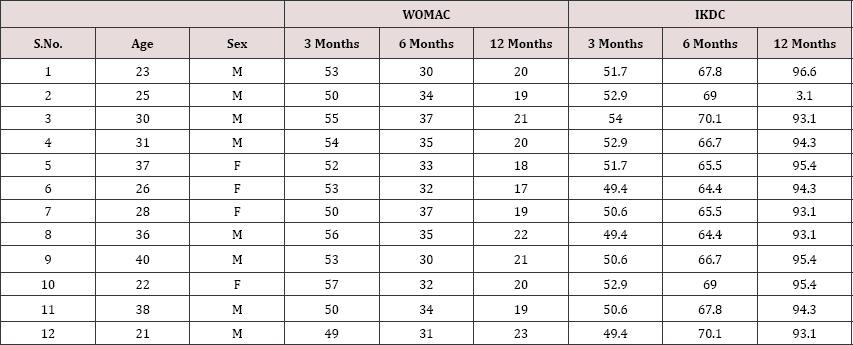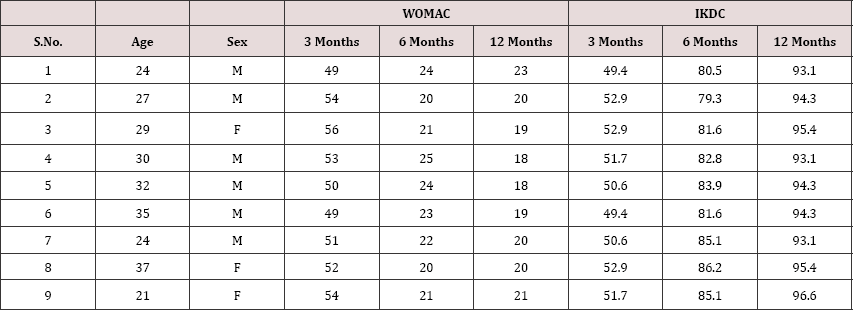Lupine Publishers | Journal of Orthopaedics
Abstract
Introduction: Cartilage lesions pose a significant problem to
surgeons, at best being replaced by poorer quality fibrocartilage post
micro-fracture. Hyaluronic acid has shown to inhibit joint degeneration
and reduce joint inflammation. This study wishes to evaluate the outcome
of visco-supplementation following micro-fracture.
Material & Method: Twenty one consecutive patients with
chondral lesion less than 2 sq cm were treated with micro-fracture and
post operatively randomly divide into two groups. One group was
supplemented with intra-articular hyaluronic acid at 3 weeks post
surgery. The patients were followed up at 3, 6 & 12 months for WOMAC
score and IKDC score.
Results: The WOMAC score and IKDC score in the
visco-supplementation group were significantly better than those of the
non visco-supplementation group at 6 months (p=0.0001). At 12 months
although the scores were significantly better than at 6 months, there
was no significant difference between the two groups (WOMAC p=0.86, IKDC
p=0.347).
Conclusion: Hyaluronic supplementations following
micro-fracture ensure an early improvement in functional scores
following micro-fracture. A longer follow up is necessary to evaluate
its role in preventing further joint degeneration.
Keywords: Micro-fracture; Visco-supplementation; Hyaluronic acid
Introduction
Athletic injuries often lead to full-thickness chondral defects,
which have limited intrinsic healing potential [1,2]. These lesions if
not managed adequately predisposes to joint degeneration [2].
Symptomatic lesions are often managed with micro-fracture to attempt
cartilage repair [3]. Bleeding from the sub-chondral bone within the
defect and subsequent clot formation covers the exposed bone. Also,
mesenchymal stem cells that migrate into the clot promote formation of
fibrocartilagenous repair tissue [4]. This filling of the defect
restores the congruity of the joint leading to symptomatic relief [5].
The viscoelastic property of the synovial fluid is credited to
Hyaluronic acid, which is often used in the non operative treatment of
early osteo-arthritis [6]. Hyaluronic acid has been shown to inhibit
degenerative changes within chondrocytes, reduce synovial inflammation
and enhance cartilage proteoglycan content along with inducing
chondrogenic differentiation from mesenchymal cells [7,8]. This study
aims to compare the functional outcome of micro-fracture with and
without visco-supplementation.
Materials and Method
In a prospective level II study, patients with chondral lesions of
ICRS grade III-IV measuring less than 2sq cm were managed with
micro-fracture and randomly divided into two groups. One group was
supplemented with a single shot intra-articular Hyaluronic acid at 3
weeks post surgery in the form of 6ml hylan G-F 20, [9] the other group
did not receive any visco-supplementation. Patients more than 45 years
of age and having generalised chondral changes were excluded from the
study. Multi-ligament injured patients and those with unmanaged single
ligament injury or unmanaged meniscus injuries were also excluded from
the study. There was no sex restriction. All the patients were put on
continuous passive motion from the first post operative day unless they
had under gone an associated PCL reconstruction or meniscus repair
surgery, in which case PCL and meniscus rehabilitation protocols were
followed. The patients were kept non weight bearing for 6 weeks followed
by full weight bearing. WOMAC score and IKDC score were evaluated at 3,
6 and 12 months post surgery.
Results
The Visco-supplementation group (Group A) had 9 patients and the
group with no supplementation (Group B) had 12 patients. All our
patients were between 21-40 years of age (Mean: 29.3 years) with 14
males. Two had associated PCL reconstruction surgery, 17 underwent ACL
reconstruction of which five underwent partial medial menisectomy and
two partial lateral menisectomy. Five patients underwent a meniscus
repair procedure. Eight of group A had grade 3-4 ICRS lesion on the
weight bearing area of medial femoral condyle while one had involvement
of the lateral femoral condyle. In group B 8 had involvement of the
medial femoral condyle. Eight had injured their knee in a game of
football, five while dancing, six while playing cricket and another two
due to fall on stairs. None were lost to follow up. None of the patients
reported any re-injury between the surgery and latest follow up. There
were no complication in any of the patients and no one required any
additional surgical intervention.
The WOMAC score in group A ranged from 54-49 (mean- 52) at 3 months,
which improved to (mean-22.2) at 6 months. The WOMAC score at 12 months
showed significant improvement from the 6 month follow up score
(p=0.024), however there was no significant difference between group A
and B at 12 months (p= 0.86). In group B the WOMAC score at 6 months was
better than that at 3 months (P=0.0001) (Table 1). But comparing with
group A, group B showed significantly poorer results at 6 months
(p=0.0001).
Table 1: WOMAC and IKDC scores of individual patients of group B at 3 months, 6 months and 12 months.

Comparing the IKDC scores, the group A patients showed
supplementation however seemed to wane away by 12 months significantly
better results compared to group B at 6 months with no significant
difference in IKDC scores between the two follow up (p=0.0001) (Table
2). The beneficial effect of visco- groups (p=0.347).
Table 2: WOMAC and IKDC scores of individual patients of group A at 3 months, 6 months and 12 months.

Discussion
Joint degeneration and poor healing potential of chondral lesions
pose a challenge to surgeons managing these lesions. Various techniques
have been described aiming to fill the defect and obtain a congruent
joint. Micro-fracture is one of such procedures in which the
sub-chondral bone plate is penetrated to cause fibrin clot formation and
later conversion to fibrocartilage [10]. Variable outcomes of
micro-fracture have been described in literature with almost 70%-90% of
patients showing improvement in function [11]. The durability of the
fibrocartilage has however been put to question with mid-term results
showing a decline in the functional scores [12,13]. Augmentation of
micro-fracture to improve the quality and durability of the repair
tissue and ensuring a more hyaline like tissue is the current interest
topic of various researchers. Strauss E et al. [10] showed a positive
effect of hyaluronic acid supplementation on repair tissue both
histologically as well as grossly.
Intra-articular basic fibroblast growth factor when used without
hyaluronic acid induces poor repair tissue besides undesirable side
effects. hyaluronic acid injection along with basic fibroblast growth
factor results in significantly better tissue quality [7]. Hyaluronic
acid has been increasingly used in the non-operative management of
osteoarthritis [14,15]. Rabbit model studies have demonstrated
hyaluronic acid to reduce arthritic changes by inhibiting degenerative
changes in chondrocytes and cartilage matrix. It also decreases synovial
inflammation and increases proteoglycan contect of cartilage [7].
Hyaluronic acid has also been shown to induce chondrogenic
differentiation in mesenchymal stem cells [8].
Tytherleigh-Strong et al. [6]. Demostrated significantly higher
aggregate moduli in the visco-supplementation group in an ovine model.
Jansen et al showed chondroprotective effect of hyaluronic acid,
preventing apoptosis of chondrocytes just adjacent to the lesion [16].
Although there are several animal studies demonstrating beneficial
effect of hyaluronic acid in cartilage healing, not much is available on
their role in human patients [10].
This study aimed to evaluate the role of visco-supplementation in
functional outcome following micro-fracture in focal chondral lesions.
The visco-supplemented group fared significantly better than the
non-supplemented group at 6 months. The beneficial effect however seemed
to wane away by one year with both groups having comparable functional
scores and subjective outcomes at 12 months follow up.
Limitations
Our sample size is small as we purposefully selected only lesions
which were less than 2sq cm in size. Credibility is added to our study
by comparing the outcomes of micro-fracture supplemented with hyaluronic
acid with those without. No patients were lost to follow up in this
series. We however, do not have any follow up MRI or repeat arthroscopy
to ascertain the healing status at the repair site. The follow up is
also a short term follow up 1 year. A longer term follow up is needed to
assess the long term outcomes of viscosupplementation in preventing
joint degeneration.
Conclusion
Supplementing micro-fracture with hyaluronic acid injection ensures
quicker return of better functional state. In the longer term however
this beneficial effect seems to wane off.
For more
Lupine Publishers Open Access Journals Please visit our website:
http://lupinepublishers.us/
For more
open access orthopedics journal articles Please Click Here:
https://lupinepublishers.com/orthopedics-sportsmedicine-journal/
To Know More About
Open Access Publishers Please Click on
Lupine Publishers



No comments:
Post a Comment
Note: only a member of this blog may post a comment.